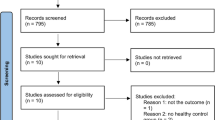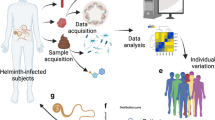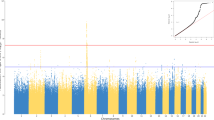Abstract
Since interleukin (IL)-10 is a key mediator of immunosuppression, and immunosuppression is considered an important element of helminth infection, we studied variants of the putative IL-10 gene promoter in 337 individuals from 130 families heavily exposed to infection by the tissue nematode Onchocerca volvulus. As shown by transmission disequilibrium tests, variants of the IL-10 promoter at positions –1082(G/A), –819(C/T), and –592(C/A) in the haplotype of ATA were significantly associated with high peripheral blood cell (PBC) proliferative responses to O. volvulus antigen (OvAg). No associations were observed using phytohemagglutinin-induced PBC proliferation or with qualitative or quantitative phenotypes of onchocerciasis or onchocerciasis-related skin disease. The findings are compatible with the hypothesis that the ATA haplotype causes a decrease in IL-10 production by OvAg-reactive type-1 regulatory T-lymphocytes, thereby alleviating the suppression of other T cells. To our knowledge, this is the first time that an influence of IL-10 promoter variants is shown on the adaptive immune response.
This is a preview of subscription content, access via your institution
Access options
Subscribe to this journal
Receive 6 digital issues and online access to articles
$119.00 per year
only $19.83 per issue
Buy this article
- Purchase on Springer Link
- Instant access to full article PDF
Prices may be subject to local taxes which are calculated during checkout

Similar content being viewed by others
References
Moore KW, de Waal Malefyt R, Coffman RL, O'Garra A . Interleukin-10 and the interleukin-10 receptor. Annu Rev Immunol 2001; 19: 683–765.
Mahanty S, Mollis SN, Ravichandran M et al. High levels spontaneous and parasite antigen-driven interleukin-10 production are associated with antigen-specific hyporesponsiveness in human lymphatic filariasis. J Infect Dis 1996; 173: 769–773.
Plebanski M, Flanagan KL, Lee EA et al. Interleukin 10-mediated immunosuppression by a variant CD4T cell epitope of Plasmodium falciparum. Immunity 1999; 10: 651–660.
King CL, Mahanty S, Kumaraswami V et al. Cytokine control of parasite-specific anergy in human lymphatic filariasis. Preferential induction of a regulatory T helper type 2 lymphocyte subset. J Clin Invest 1993; 92: 1667–1673.
Osborne J, Devaney E . Interleukin-10 and antigen-presenting cells actively suppress Th1 cells in BALB/c mice infected with the filarial parasite Brugia pahangi. Infect Immun 1999; 67: 1599–1605.
Hoffmann WH, Pfaff AW, Schulz-Key H, Soboslay PT, Soboslav PT . Determinants for resistance and susceptibility to microfilaraemia in Litomosoides sigmodontis filariasis. Parasitology 2001; 122: 641–649.
Namangala B, Noel W, De Baetselier P, Brys L, Beschin A . Relative contribution of interferon-gamma and interleukin-10 to resistance to murine African trypanosomosis. J Infect Dis 2001; 183: 1794–1800.
Li C, Corraliza I, Langhorne J . A defect in interleukin-10 leads to enhanced malarial disease in Plasmodium chabaudi chabaudi infection in mice. Infect Immun 1999; 67: 4435–4442.
Kuhn R, Lohler J, Rennick D, Rajewsky K, Muller W . Interleukin-10-deficient mice develop chronic enterocolitis. Cell 1993; 75: 263–274.
Westendorp RG, Langermans JA, Huizinga TW et al. Genetic influence on cytokine production and fatal meningococcal disease. Lancet 1997; 349: 170–173.
Eskdale J, Gallagher G, Verweij CL, Keijsers V, Westendorp RG, Huizinga TW . Interleukin 10 secretion in relation to human IL-10 locus haplotypes. Proc Natl Acad Sci USA 1998; 95: 9465–9470.
de Jong BA, Westendorp RG, Eskdale J, Uitdehaag BM, Huizinga TW . Frequency of functional interleukin-10 promoter polymorphism is different between relapse-onset and primary progressive multiple sclerosis. Hum Immunol 2002; 63: 281–285.
Turner DM, Williams DM, Sankaran D, Lazarus M, Sinnott PJ, Hutchinson IV . An investigation of polymorphism in the interleukin-10 gene promoter. Eur J Immunogenet 1997; 24: 1–8.
Crawley E, Kay R, Sillibourne J, Patel P, Hutchinson I, Woo P . Polymorphic haplotypes of the interleukin-10 5' flanking region determine variable interleukin-10 transcription and are associated with particular phenotypes of juvenile rheumatoid arthritis. Arthritis Rheum 1999; 42: 1101–1108.
Koss K, Satsangi J, Fanning GC, Welsh KI, Jewell DP . Cytokine (TNF alpha, LT alpha and IL-10) polymorphisms in inflammatory bowel diseases and normal controls: differential effects on production and allele frequencies. Genes Immun 2000; 1: 185–190.
Lowe PR, Galley HF, Abdel-Fattah A, Webster NR . Influence of interleukin-10 polymorphisms on interleukin-10 expression and survival in critically ill patients. Crit Care Med 2003; 31: 34–38.
Gibson AW, Edberg JC, Wu J, Westendorp RG, Huizinga TW, Kimberly RP . Novel single nucleotide polymorphisms in the distal IL-10 promoter affect IL-10 production and enhance the risk of systemic lupus erythematosus. J Immunol 2001; 166: 3915–3922.
Kaluza W, Leirisalo-Repo M, Marker-Hermann E et al. IL10.G microsatellites mark promoter haplotypes associated with protection against the development of reactive arthritis in Finnish patients. Arthritis Rheum 2001; 44: 1209–1214.
Craven NM, Jackson CW, Kirby B et al. Cytokine gene polymorphisms in psoriasis. Br J Dermatol 2001; 144: 849–853.
Hulkkonen J, Pertovaara M, Antonen J, Lahdenpohja N, Pasternack A, Hurme M . Genetic association between interleukin-10 promoter region polymorphisms and primary Sjogren's syndrome. Arthritis Rheum 2001; 44: 176–179.
Hoerauf A, Brattig N . Resistance and susceptibility in human onchocerciasis—beyond Th1 vs Th2. Trends Parasitol 2002; 18: 25–31.
Timmann C, Abraha RS, Hamelmann C et al. Cutaneous pathology in onchocerciasis associated with pronounced systemic T-helper 2-type responses to Onchocerca volvulus. Br J Dermatol 2003; 149: 782–787.
Doetze A, Satoguina J, Burchard G et al. Antigen-specific cellular hyporesponsiveness in a chronic human helminth infection is mediated by T(h)3/T(r)1-type cytokines IL-10 and transforming growth factor-beta but not by a T(h)1 to T(h)2 shift. Int Immunol 2000; 12: 623–630.
Bloemena E, Roos MT, Van Heijst JL, Vossen JM, Schellekens PT . Whole-blood lymphocyte cultures. J Immunol Methods 1989; 122: 161–167.
Fleischer B . Activation of human T lymphocytes II. Involvement of the T3 antigen in polyclonal T cell activation by mitogenic lectins and oxidation. Eur J Immunol 1984; 14: 748–752.
Brattig NW, Lepping B, Timmann C et al. Onchocerca volvulus-exposed persons fail to produce interferon-gamma in response to O. volvulus antigen but mount proliferative responses with interleukin-5 and IL-13 production that decrease with increasing microfilarial density. J Infect Dis 2002; 185: 1148–1154.
Huang L, Krieg AM, Eller N, Scott DE . Induction and regulation of Th1-inducing cytokines by bacterial DNA, lipopolysaccharide, and heat-inactivated bacteria. Infect Immun 1999; 67: 6257–6263.
Reuss E, Fimmers R, Kruger A, Becker C, Rittner C, Hohler T . Differential regulation of interleukin-10 production by genetic and environmental factors—a twin study. Genes Immun 2002; 3: 407–413.
Satoguina J, Mempel M, Larbi J et al. Antigen-specific T regulatory-1 cells are associated with immunosuppression in a chronic helminth infection (onchocerciasis). Microbes Infect 2002; 4: 1291–1300.
Conti P, Kempuraj D, Frydas S et al. IL-10 subfamily members: IL-19, IL-20, IL-22, IL-24 and IL-26. Immunol Lett 2003; 88: 171–174.
WHO Expert Committee on Onchocerciasis. Third report. World Health Organ Tech Rep Ser 1987; 752: 1–167.
Murdoch ME, Hay RJ, Mackenzie CD et al. A clinical classification and grading system of the cutaneous changes in onchocerciasis. Br J Dermatol 1993; 129: 260–269.
Abecasis GR, Cookson WO . GOLD—graphical overview of linkage disequilibrium. Bioinformatics 2000; 16: 182–183.
Kruglyak L, Lander ES . Complete multipoint sib-pair analysis of qualitative and quantitative traits. Am J Hum Genet 1995; 57: 439–454.
Abecasis GR, Cardon LR, Cookson WO . A general test of association for quantitative traits in nuclear families. Am J Hum Genet 2000; 66: 279–292.
McIntyre LM, Martin ER, Simonsen KL, Kaplan NL . Circumventing multiple testing: a multilocus Monte Carlo approach to testing for association. Genet Epidemiol 2000; 19: 18–29.
Acknowledgements
The study was supported by the Deutsche Forschungsgemeinschaft (HO 866/4-1) and the Volkswagen Foundation, Germany. This work is part of the doctoral thesis of CT at the Faculty of Medicine, University of Hamburg, Germany.
Author information
Authors and Affiliations
Corresponding author
Rights and permissions
About this article
Cite this article
Timmann, C., Fuchs, S., Thoma, C. et al. Promoter haplotypes of the interleukin-10 gene influence proliferation of peripheral blood cells in response to helminth antigen. Genes Immun 5, 256–260 (2004). https://doi.org/10.1038/sj.gene.6364094
Received:
Revised:
Accepted:
Published:
Issue Date:
DOI: https://doi.org/10.1038/sj.gene.6364094
Keywords
This article is cited by
-
Anti-inflammatory mechanisms of the novel cytokine interleukin-38 in allergic asthma
Cellular & Molecular Immunology (2020)
-
Regulatory T cells and immune regulation of allergic diseases: roles of IL-10 and TGF-β
Genes & Immunity (2014)
-
IL-10, IL-6 and CD14 polymorphisms and sepsis outcome in ventilated very low birth weight infants
BMC Medicine (2006)



